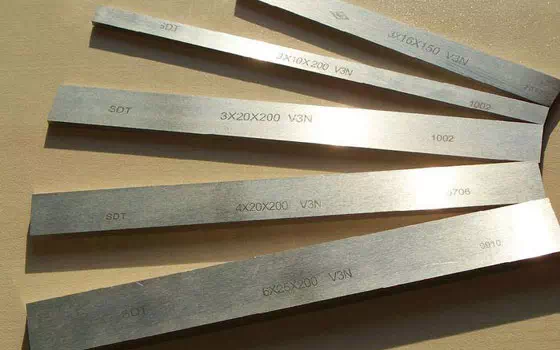Also known as wind steel or front steel, also known as white steel. It means that quenching can harden even when cooled in air, and it is very sharp. It is a complex alloy steel containing tungsten, molybdenum, chromium, vanadium, cobalt and other carbide forming elements. The total amount of alloying elements is about 10 ~ 25%. It can still maintain high hardness in the case of high heat generated by high-speed cutting (about 500 ° C), and HRC can be above 60. This is the most important characteristic of high-speed steel - red hardness. The carbon tool steel after quenching and low temperature tempering, although there is a high hardness at room temperature, but when the temperature is higher than 200 ° C, the hardness will drop sharply, at 500 ° C hardness has been reduced to a similar degree with the annealing state, completely lost the ability to cut metal, which limits the carbon tool steel production cutting tools. The high speed steel due to good red hardness, make up for the fatal shortcomings of carbon tool steel, can be used to manufacture cutting tools.
High speed steel generally does not do tensile strength testing, but mainly to metallographic and hardness testing.
Tungsten and molybdenum high speed steel after the correct heat treatment, Rockwell hardness can reach more than 63, cobalt high speed steel in more than 65. The acid-soaked low-power tissue of steel shall not have visible shrinkage holes and peeling. Central loose, generally loose should be less than 1 level.

The content of metallographic examination mainly includes three items: decarbonized layer, microstructure and carbide inhomogeneity.
1. High speed steel should not be significantly decarbonized. There should be no fishbone eutectic letenite in the microstructure.
2. The non-uniformity of carbide in high-speed steel has the greatest impact on quality, and the metallurgical and mechanical departments attach great importance to the level of carbide non-uniformity. According to the different uses of steel, different levels of carbide non-uniformity can be put forward, usually less than 3 levels.
3. Manufacturing cutting tools with high-speed steel, in addition to its high hardness, high wear resistance and enough toughness, there is an important factor is the red hardness. (Red hardness refers to the ability of the cutting tool to resist softening under red heat when cutting at high speed.)
One way to measure the hardness of the red is to heat the steel to 580 ~ 650 ° C, hold it for 1 hour, and then cool it, so that the hardness value is measured after four times. The quenching temperature of high-speed steel is generally close to the melting point of steel, such as tungsten high-speed steel is 1210 ~ 1240℃, and high molybdenum high-speed steel is 1180 ~ 1210℃. After quenching, it is generally necessary to temper three times between 540 and 560 ° C. Increasing the quenching temperature can increase the red hardness of the steel. In order to improve the service life of high-speed steel tools, the surface can be strengthened, such as low temperature cyaniding, nitriding, sulfur nitriding and so on.
评论
发表评论